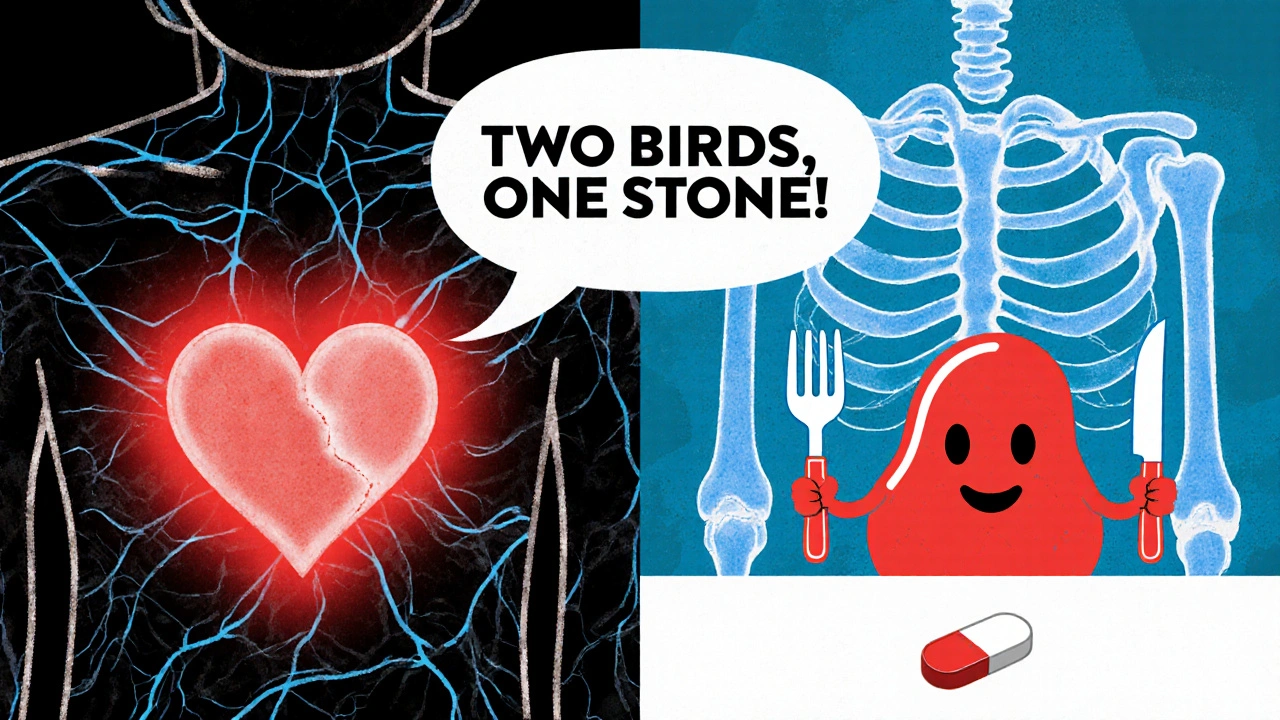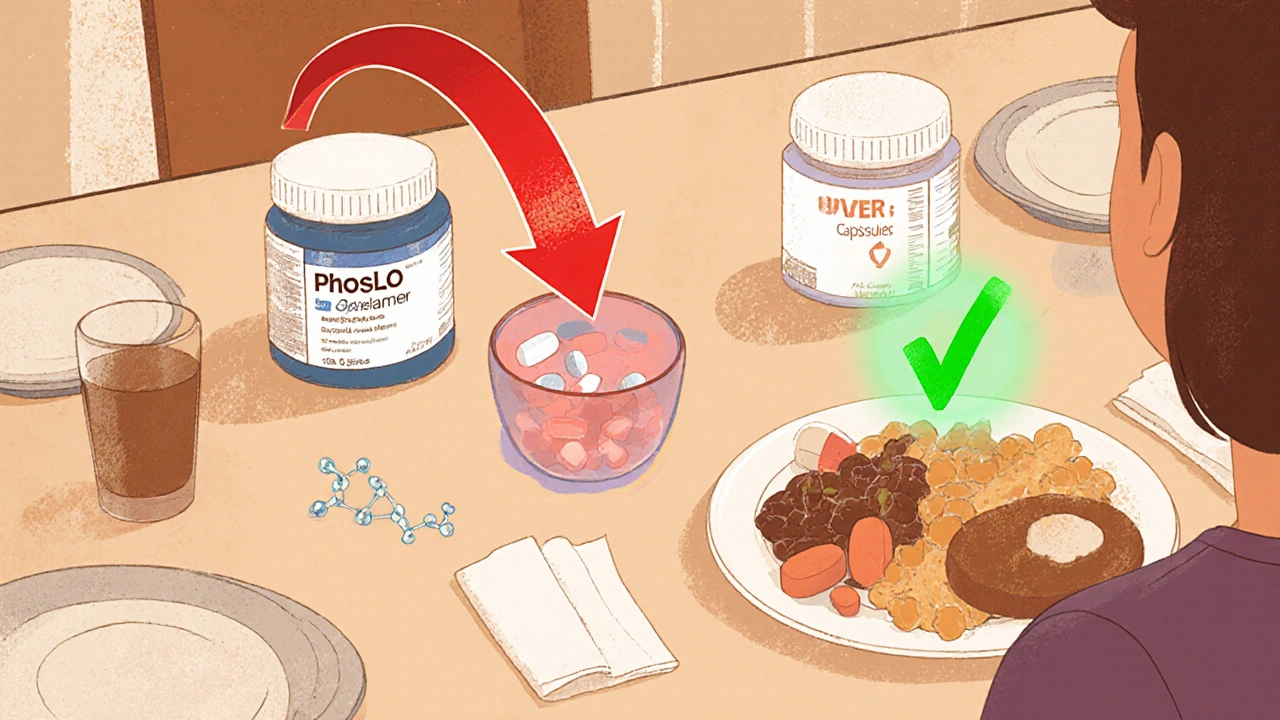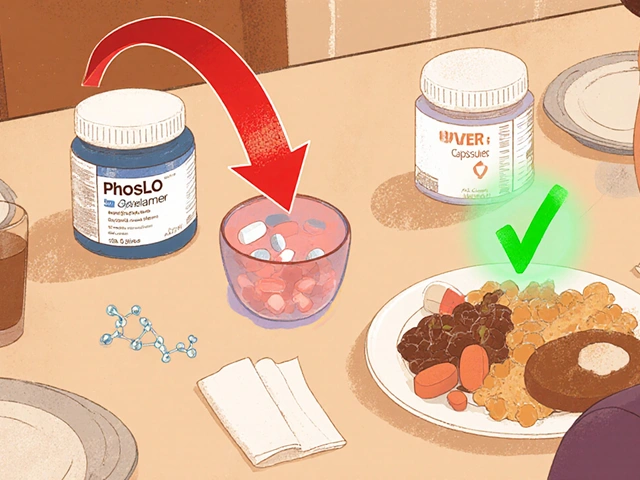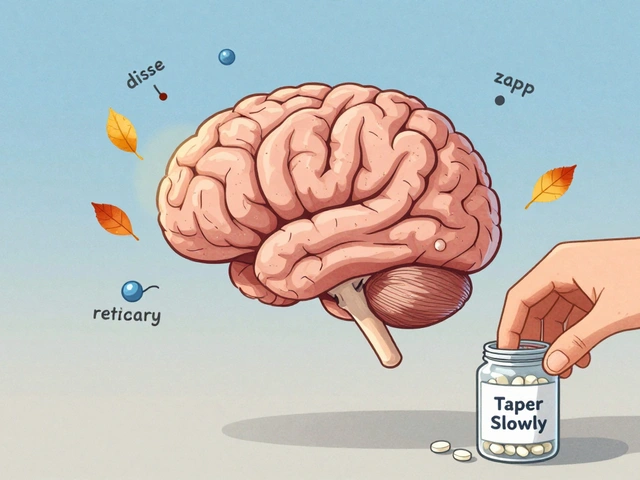When you’re managing kidney disease, high phosphate levels aren’t just a lab number-they’re a silent threat to your heart, bones, and overall health. PhosLo (calcium acetate) has been a go-to phosphate binder for years, but it’s not the only option. If you’ve been prescribed PhosLo and are wondering whether there’s something better, cheaper, or easier to take, you’re not alone. Many people on dialysis or with advanced kidney disease face this exact question. Let’s break down how PhosLo stacks up against other phosphate binders, what really matters in daily use, and which alternatives might work better for your body and lifestyle.
What PhosLo (Calcium Acetate) Actually Does
PhosLo is a brand name for calcium acetate, a medication that binds to phosphate in your food before your body absorbs it. When you eat, phosphate from meat, dairy, processed foods, and sodas enters your gut. Without a binder, your kidneys-especially if they’re damaged-can’t filter it out. That phosphate builds up, leading to dangerous calcification in your arteries, weak bones, and itchy skin. PhosLo works by attaching to that dietary phosphate and carrying it out in your stool instead of letting it enter your bloodstream.
It’s taken with meals, usually 2-3 times a day, depending on how much you eat. Each tablet typically contains 667 mg of calcium acetate, which provides about 200 mg of elemental calcium. That’s important because while it helps control phosphate, it also adds calcium to your system. For some people, that’s a benefit. For others, it’s a risk.
Why People Look for Alternatives to PhosLo
PhosLo works-but it comes with trade-offs. First, the calcium load. If your blood calcium is already high, or if you’re on vitamin D supplements, extra calcium from PhosLo can push you into hypercalcemia. That means nausea, confusion, fatigue, and even heart rhythm problems. Second, it’s bulky. You might need 2-4 tablets per meal, which adds up to 12-18 pills a day. That’s hard to swallow, literally. Third, cost. Brand-name PhosLo can run over $100 a month without insurance. Generic calcium acetate is cheaper, but still expensive compared to some other binders.
Many patients switch because of side effects: constipation, bloating, or stomach upset. Others switch because their doctor wants to reduce calcium intake. And some just want fewer pills. That’s where alternatives come in.
Sevelamer (Renvela, Renagel): The Non-Calcium Option
Sevelamer is the most common alternative to PhosLo. Sold as Renvela (swallowable tablets) or Renagel (capsules), it binds phosphate without adding calcium. That makes it ideal for people with high blood calcium, parathyroid issues, or those at risk of vascular calcification.
It’s effective-studies show it lowers phosphate just as well as calcium acetate. But it’s not without downsides. Sevelamer can cause more gastrointestinal upset: nausea, vomiting, diarrhea. It’s also more expensive than PhosLo, even as a generic. And you still need to take a lot of pills-usually 2-3 with each meal. Renvela is available in a powder form (Renvela Powder) that’s easier to mix into food or drinks, which helps people who struggle with swallowing pills.
Unlike PhosLo, sevelamer doesn’t interfere with vitamin D absorption, so it’s often preferred when patients are on active vitamin D therapy. It’s also safer for long-term use in people with osteoporosis or bone disease.
Calcium Carbonate: The Cheap and Common Choice
Over-the-counter calcium carbonate, like Tums or generic antacids, is a direct competitor to PhosLo. It’s the same mechanism-binds phosphate with calcium-but it’s cheaper. A 1000-pill bottle of calcium carbonate can cost under $10. Many nephrologists prescribe it off-label as a phosphate binder.
It’s effective, especially at higher doses. One 500 mg tablet of calcium carbonate delivers 200 mg of elemental calcium-same as PhosLo. But because it’s so cheap, it’s often used as a first-line option, especially in places with limited healthcare access.
But here’s the catch: calcium carbonate is more likely to cause hypercalcemia than calcium acetate. It’s also more alkaline, which can lead to acid-base imbalances. And if you take it without food, it won’t work. You must take it right when you eat. Many people forget, or take it too early or too late, making it unreliable.
It’s a good budget option if you’re closely monitored. But if your calcium levels creep up, your doctor will likely switch you to something else.
Lanthanum Carbonate (Fosrenol): The High-Potency Option
Fosrenol is a chewable tablet made of lanthanum carbonate. It’s one of the strongest phosphate binders available. You need fewer tablets-often just 1-2 per meal. That’s a big win for people tired of swallowing a handful of pills every day.
It doesn’t contain calcium or aluminum, so it won’t raise your calcium or cause aluminum toxicity. It’s also less likely to cause constipation than sevelamer. But it has its own quirks. You have to chew the tablet thoroughly-swallowing it whole won’t work. Many people find the taste unpleasant, and it can stain teeth if not rinsed properly after use.
Studies show it lowers phosphate more effectively than calcium acetate in some patients, especially those with very high levels. It’s pricier than PhosLo, but often covered by insurance for patients who fail other binders. It’s also the go-to choice for people who need a potent binder but can’t tolerate calcium or sevelamer.
Iron-Based Binders: The New Kid on the Block
Two newer options-ferric citrate (Auryxia) and sucroferric oxyhydroxide (Velphoro)-are changing the game. They’re iron-based, so they bind phosphate and also help treat iron deficiency, which is common in kidney patients.
Auryxia comes as tablets or powder. It’s taken with meals. In addition to lowering phosphate, it can reduce the need for IV iron or erythropoiesis-stimulating drugs. That’s a huge plus if you’re anemic. Velphoro is a chewable tablet with a sweet flavor, designed to be more palatable. Both are non-calcium, non-aluminum options.
Side effects? Stool darkening (normal, not dangerous), nausea, and diarrhea. But the biggest benefit: you’re not just managing phosphate-you’re helping your anemia too. That’s why many doctors now consider iron-based binders as first-line for patients with both high phosphate and low iron.
Comparison Table: PhosLo vs. Alternatives
| Medication | Active Ingredient | Calcium Content | Dosing Frequency | Common Side Effects | Cost (Monthly, Approx.) |
|---|---|---|---|---|---|
| PhosLo | Calcium acetate | Yes | 2-4 tablets per meal | Constipation, bloating, hypercalcemia | $80-$120 |
| Sevelamer (Renvela) | Sevelamer hydrochloride | No | 2-3 tablets per meal | Nausea, diarrhea, gas | $150-$250 |
| Calcium Carbonate (Tums) | Calcium carbonate | Yes | 2-4 tablets per meal | Hypercalcemia, acid rebound | $5-$15 |
| Fosrenol | Lanthanum carbonate | No | 1-2 chewable tablets per meal | Chewable texture, tooth staining | $180-$220 |
| Auryxia | Ferric citrate | No | 1-3 tablets per meal | Dark stools, nausea, diarrhea | $160-$200 |
| Velphoro | Sucroferric oxyhydroxide | No | 1-3 chewable tablets per meal | Sweet taste, dark stools | $170-$210 |

Which One Is Right for You?
There’s no universal best binder. It depends on your blood work, your budget, how many pills you can handle, and your other health conditions.
If you have high calcium levels or bone disease, skip PhosLo and calcium carbonate. Go with sevelamer, lanthanum, or an iron-based binder.
If you’re anemic and need iron, Auryxia or Velphoro might be your best bet. You get phosphate control plus help with low iron-two birds with one stone.
If cost is the biggest issue and your doctor monitors your calcium closely, generic calcium carbonate can work. But don’t use it long-term without regular blood tests.
If swallowing pills is a struggle, look at Renvela Powder, Fosrenol chewables, or Velphoro. They’re easier to take and often better tolerated.
What Your Doctor Will Check Before Switching
Your doctor won’t just swap binders on a whim. They’ll look at:
- Your serum phosphate level-ideally under 5.5 mg/dL
- Your serum calcium-should be normal, not high
- Your parathyroid hormone (PTH)-high levels mean your bones are releasing calcium
- Your iron and ferritin levels-if low, iron-based binders become more attractive
- Your medication list-some drugs interact with binders
They’ll also check how well you’re sticking to your diet. No binder works if you’re eating a lot of processed cheese, colas, or instant soups. Phosphate is everywhere in modern food. Medication is only half the battle.
What to Do If PhosLo Isn’t Working
If your phosphate stays high despite taking PhosLo as directed, it’s not necessarily because the drug failed. It could mean:
- You’re not taking it with every meal
- You’re eating too many high-phosphate foods
- You need a higher dose
- Your kidneys are getting worse
- You need a different type of binder
Don’t just increase the dose on your own. Talk to your nephrologist. They might add a second binder-like combining a low dose of PhosLo with a small amount of sevelamer-to get better control without side effects.
Final Thoughts
PhosLo is a solid, proven option. But it’s not the only one-and for many people, it’s not the best. The landscape of phosphate binders has changed. Today, you have choices that are easier to take, safer for your bones, and even help with anemia. The key is matching the binder to your body, not just your prescription pad.
Ask your doctor: "Is there a binder that’s better for my calcium levels?" or "Can we try something with fewer pills?" or "Would an iron-based binder help my anemia too?" The right answer could make your daily routine easier-and your long-term health stronger.
Can I take PhosLo without food?
No. PhosLo only works when taken with meals. It binds to phosphate in food, so if you take it on an empty stomach, it won’t do anything. Always take it right when you start eating.
Is generic calcium acetate the same as PhosLo?
Yes. Generic calcium acetate has the same active ingredient and works the same way as PhosLo. The only differences are the brand name, packaging, and price. Many patients switch to generic to save money without losing effectiveness.
Do phosphate binders cause kidney damage?
No. Phosphate binders are used because your kidneys are already damaged. They don’t cause kidney injury. In fact, keeping phosphate levels under control helps protect your heart and blood vessels from further damage. The real risk comes from high phosphate levels, not the binders.
Can I stop taking phosphate binders if my levels improve?
Only under your doctor’s supervision. Even if your phosphate levels drop, you still need the binder unless your kidney function improves significantly-which is rare in advanced disease. Stopping suddenly can cause phosphate to spike again, increasing your risk of heart problems.
Which binder is safest for long-term use?
Iron-based binders like Auryxia and Velphoro are often preferred for long-term use because they don’t raise calcium or aluminum levels. Sevelamer is also safe over time. Calcium-based binders like PhosLo carry a higher risk of calcification in blood vessels if used long-term without monitoring.
How do I know if my phosphate binder is working?
Your blood tests will show your phosphate level dropping toward the target range (usually 3.5-5.5 mg/dL). You may also notice less itching, better sleep, and fewer bone aches. But the only real way to know is through regular lab work-typically every 1-3 months.









Dana Dolan
20 Nov 2025 at 06:52PhosLo gave me serious constipation-like, ‘can’t-move-for-days’ level. Switched to Fosrenol and now I just chew it like a gummy bear (gross taste, but hey). Fewer pills, no calcium overload. My nephrologist was shocked I stuck with it.